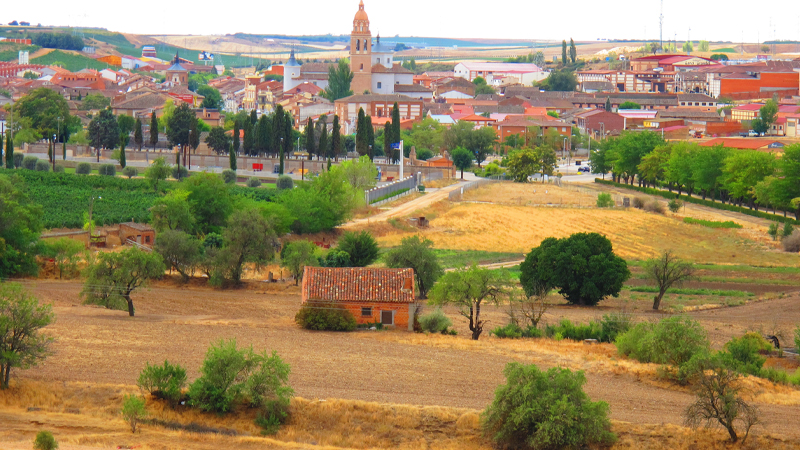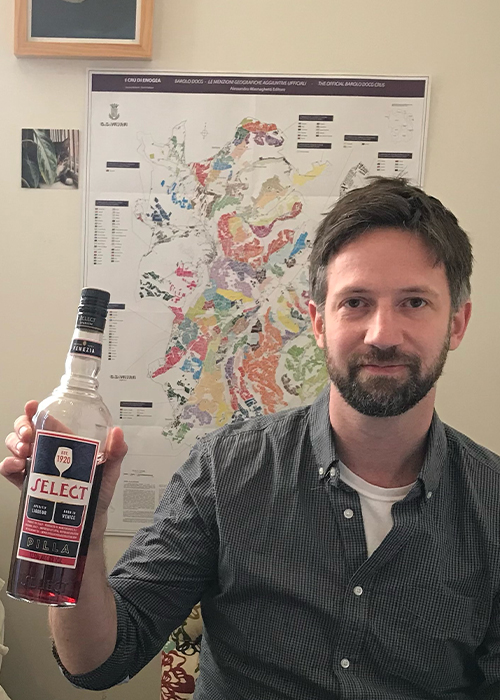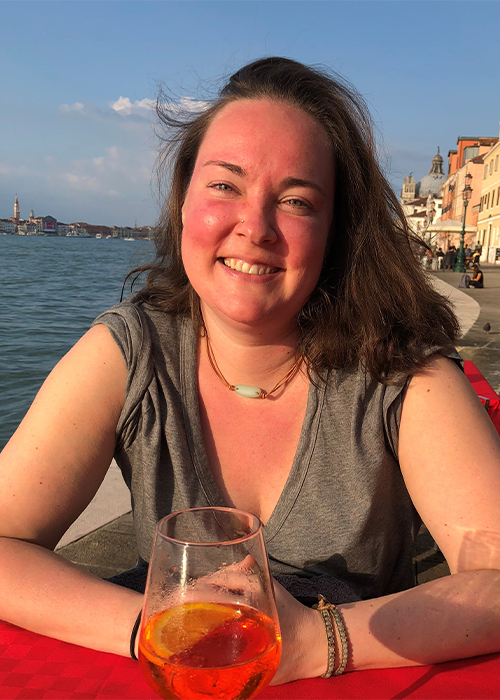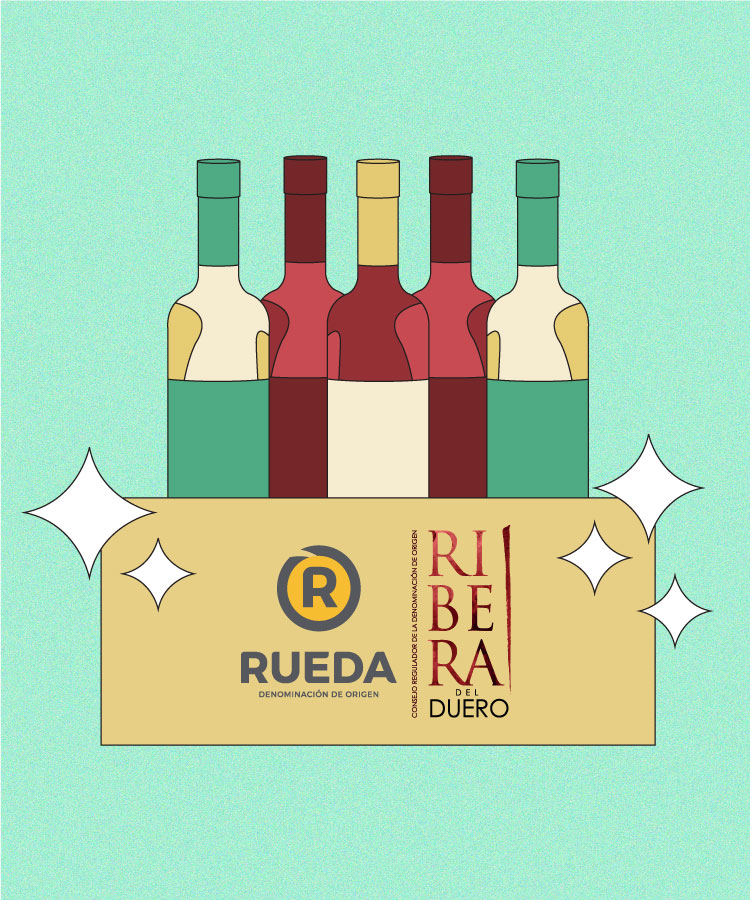
While international travel is unfortunately difficult right now, participants in VinePair’s most recent masterclass were seamlessly transported — by bottle — to Ribera del Duero and Rueda. The sister Spanish wine regions, located two hours north of Madrid, each have their own defining characteristics and unique specialty, and together produce a bounty of reds and whites that have every palate, cuisine, and occasion well covered.
Ribera is the dream destination for fans of Spain’s most well-known grape, Tempranillo — known locally as “Tinto Fino” — which is best explained by experts on the region as being “big, bold, and textured, but with plenty of rich, Old-World sensibility.” While they pack a punch of flavor and pinch of smoke and spice, the wines produced in this region are still quite refined, consistently food-friendly, and often ripe and ready to be consumed young.
Rueda, meanwhile, is home to Verdejo and is Spain’s most popular white wine region. Here, in the extreme climates and intense sun, the ancient grape thrives and is crafted into unique and refreshing white wines. These are succinctly described as “aromatic and medium- or full-bodied with lively acidity,” making them the ideal (experience-enhancing) complement to an array of dishes, from shellfish to Asian cuisine.
During VinePair’s masterclass, wine professionals explored these two regions and some of the incredible wines they’ve yielded through a tasting and instruction guided by Alexander LePratt, a highly regarded industry expert and Master Sommelier who in 2011 earned the title “Best Sommelier in America” from the American Sommelier Association.

While everyone who participated was a winner of sorts, there were two individuals with a true thirst for knowledge. These wine pros not only tasted reds and whites, but victory as well, and demonstrated their mastery of Ribera y Rueda by dominating the end-of-course quizzes.
To take advantage of their excitement and expertise, we asked the two masterclass winners — Ryan Totman, who scored the highest on Ribera, and Ashley Schnepp, who took Rueda — to each build a dream case featuring their favorite bottles from their respective region.
RIBERA DEL DUERO
Ask Ryan Totman what wine he usually drinks, and he doesn’t have a straight answer.
“I’m all over the place,” he admits, his response demonstrating an open mind and appreciation for a range of wines that serve him well as the beverage director at Corkbuzz, a wine bar with two locations in NYC.
At work, a few of Ryan’s creative duties include running the wine list and teaching tasting classes. He’s also working toward accreditations to broaden his own knowledge. This means taking the time to learn about wines, their producers and regions, which range from beautifully crafted classics and the historic figures who laid their foundations to the most interesting, innovative wines on the market right now.

“We’re always studying,” he says. “As a working sommelier … there’s never a moment when you’re not trying to expose yourself to what’s new.”
Ryan expressed his appreciation for both the class and Alex LePratt’s presentation style (a refreshing change, and definite upgrade, from the flashcards he knows so well), as well as the context the course provided.
Ryan’s Ribera del Duero Picks:
Tinto Pesquera Reserva ’12 – Valladolid
Ryan says: “Definitely need something from the Fernández Rivera family with their influence on the Tempranillo varietal in the 1970s. Stick with the original Pesquera and a Reserva with a little age, from a successful vintage. I like the look of their older labels.”
Goyo Garcia Viadero ‘Finca Guijarrales’ Graciano ’17 – Roa, Burgos
Ryan says: “According to Vine Trail, ‘Goyo Garcia Viadero started to work at his family’s bodega at age 14 and continued while studying agronomy at the university. …. He bottled his first wine without sulphur under his name in 1986 at 21 years old.’ Goyo’s focus is recovering old co-planted vines around Roa and Aranda de Duero. Goyo manages more than 40 hectares, vinifies around 10 hectares, and sells to major wineries like Dominio de Atauta and Pesquera. Pushing the envelope a little, it’d be fun to have his Finca Guijarrales, made entirely from Graciano grown from a high-elevation, north-facing vineyard.”
Dominio de Atauta ‘Llanos del Almendro’ ’05 or ’04 – Soria
Ryan says: “Venture east to Soria. Out of the historic producer’s single-vineyard releases, ‘La Mala’ and ‘Valdegatiles’ being the other two, it’d be awesome to have their most limited bottling ‘Llanos del Almendro’ from pre-phylloxera vines planted 120 to 140 years ago grown on sandy soils.”
Bodegas Hornillos Ballesteros ‘Mibal’ ’19 – Roa, Burgos
Ryan says: “We’ve consistently had wines from Hornillos Ballesteros on our list at Corkbuzz over the years, and the wines always drink well. It’d be nice to round out the case with a wine that has the more signature style of Ribera del Duero with darker fruit, a little added body, relatively soft tannins, that is meant to be enjoyed on a regular basis, and also highlight some of the smaller ‘garage’ wineries from the region. Both descended from families of winemakers, Miguel Plates and Javier Ballesteros.”
Ryan says: “Similar to Hornillos Ballesteros, another tiny operation, but more of a fresh, easy drinking example of Ribera del Duero. [Bowler Wine has written about the project and notes that the] ‘Young winemaker Germán R. Blanco [works] in the small town of La Aguilera, Burgos. From old Tempranillo vines, he makes wines aged in different types and sizes of casks and barrels. The winery is named after Germán’s son, Lucas, who they lovingly refer to as ‘Mi Lu’ or Milú.’ A random discovery for myself, someone that I don’t see represented too often. I’ve enjoyed their ‘La Cometa,’ which is slightly fuller than Milú.”
Dominio del Águila ‘Pícaro’ Clarete ’16 – Burgos
Ryan says: “I discovered this wine in a VinePair article about Ribera del Duero Clarete, as it was a recommendation from James Dillman, sommelier at Casa Mono. Finishing with the region’s origins and its underground history, [some say] Clarete is the original wine of Ribera del Duero. [For those who need a refresher, VinePair explains that Clarete was originally] ‘a peasant wine made in small, underground wineries dating back to the 12th cent, [when] winemaking families would press, blend, ferment, and age all the red and white grapes together, producing light, deep rosé styles.’ I’d also like to try their Albillo as a white wine.”
RUEDA
An English professor turned Whole Foods beverage specialist, Ashley Schnepp usually opts for white wines well suited to the heat and humidity of “blazing hot” Franklin, Tenn., where she now lives with her partner and two Schnauzers.
Given her professional past life in academics, it makes sense why Ashley registered for this VinePair masterclass. Armed with that knowledge, and a background teaching creative writing, it was no surprise that she was able to express her passion for her work, and this art form as a whole, so poetically:
“One of the things I love about wine is there’s always something to learn,” Ashley says. “Wine is a story in a bottle.”

Along with enjoying the learning experience — and, of course, the actual tasting of the Rueda wines, which she paired with a spread of homemade tapas that included, “what’s the thing that Gordon Ramsay is always screaming? Scallops!” — Ashley also looks forward to imparting this knowledge and sharing these new wines and stories with her customers. Students of a different sort, sharing this knowledge with consumers has given Ashley a purpose that feels particularly important during a time when international exploration is off the table.
“I think being able to try bottles from around the world right now is kind of our form of travel,” she says. “It’s a little bit of experiencing another culture, another country, one sip at a time.”
Ashley’s Rueda Picks:
Ashley says: “I love the wonderful minerality of this wine. You can smell wet stones on the nose and feel yourself being transported to this old Spanish vineyard with its deep gravel soil.”
Martinsancho’s founder and first winemaker, Ángel Rodríguez Vidal, was actually one of the founding members of DO Rueda. After working on his family’s centuries-old vineyards for years, Vidal advocated to save the Verdejo variety, and was awarded the Cross Title of the Civil Order of Agricultural Merit by King Don Juan Carlos for his efforts.
Bodegas Jose Pariente – Verdejo 2019
Ashley says: “I chose this one because I find the mouthfeel to be quite nice from the time spent on the lees, and its elegance makes it a great companion to a wide variety of tapas.”
A family affair, Ignacio and Martina Pariente recently took over the José Pariente winery from their parents. There, Martina is now the head winemaker, and credits her mother as her main inspiration. While new to the reigns, the brother-sister duo see their youth as an asset and are quickly turning heads as they introduce new technology and promote greater access to their family’s thoughtful wines.
Bodega Belondrade y Lurton Verdejo
Ashley says: “This is a little harder to find, but it is well worth it if you can. The traditional Verdejo flavors are amplified by the usage of oak aging, which adds a wonderful nuttiness.”
Grupo Yllera, Cantosán Reserva Brut Nature
Ashley says: “We have a bubbly version next. Rueda doesn’t export a lot of this stuff, but if you can find it, you need to go for it! The mousse is fine, and the racy acidity and lime zest are balanced by undertones of buttered toast. Delightful.”
Oro De Castilla – Verdejo 2019
Ashley says: “Translated, this wine is ‘the Gold of Castille,’ and it is a stellar example of Rueda Verdejo. I would put this organically grown, vegan wine up against some Sancerre. … The quality for the cost would have me leaning toward this bottle.”
Ashley says: “This beauty utilizes the pre-phylloxera vines of the vineyard, plus some newer vines to create a great little treat.” They also make an organic option.
If you’re interested in trying these wines for yourself, head to your favorite wine store, or visit Mr. D wines for a special 15 percent discount on two-plus bottles of Ribera y Rueda. There, you’ll find most of the wines listed in this article, but don’t stop there — explore the incredible diversity of these wine regions and soon you’ll be able to build your dream case of Ribera del Duero y Rueda wines.
This article is sponsored by D.O. Rueda and D.O. Ribera del Duero.
